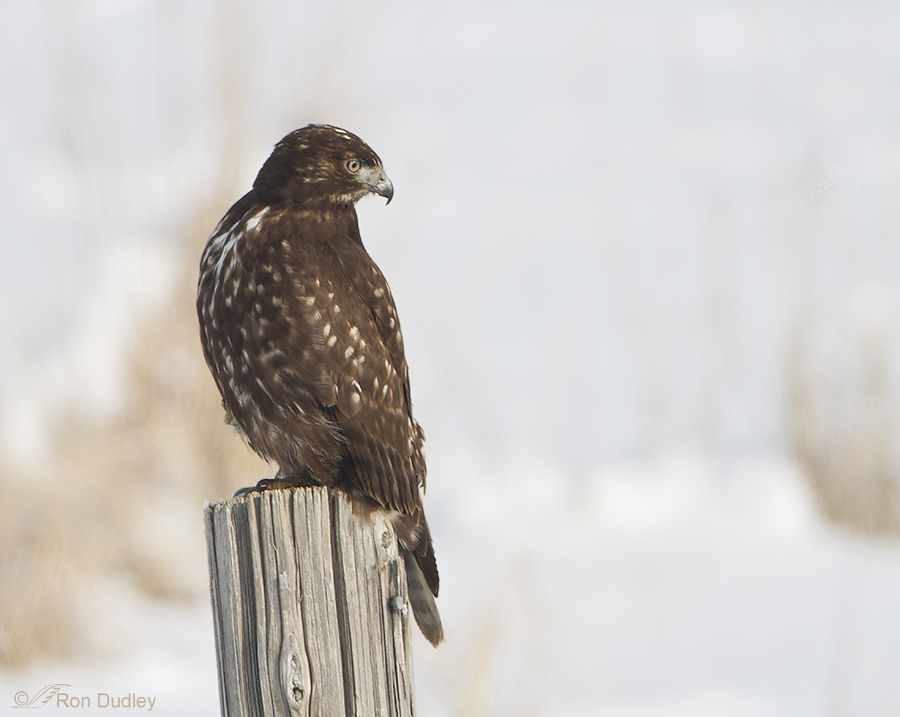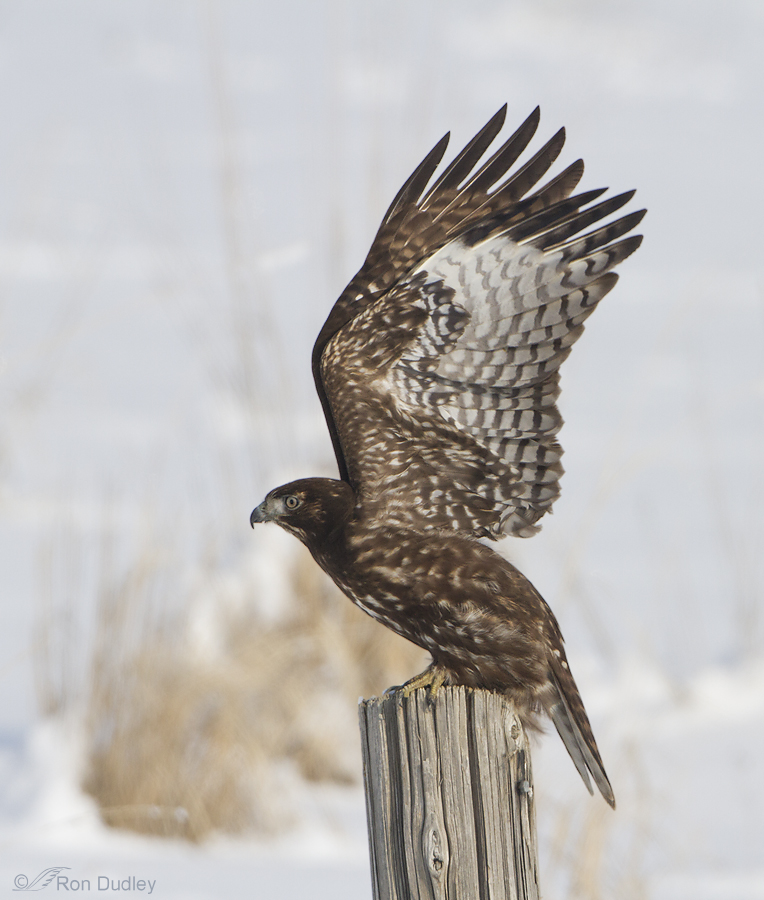Harlan’s Hawk is today considered to be a sub-species of the Red-tailed Hawk but its classification has a colorful history as it has twice been considered a separate species and twice as a race of the Red-tailed Hawk. The controversy continues today as several “experts” lobby to have the Harlan’s reinstated as a distinct species.
In 1831 John James Audubon originally named this bird Harlan’s Buzzard, after his good friend Dr. Richard Harlan of Philadelphia.

1/2000, f/7.1, ISO 400, 500 f/4, 1.4 tc, natural light, not baited, set up or called in
Harlan’s Hawks are quite similar to western Red-tailed Hawks but typically they are “colder/blacker” in overall color, with the tendency toward dusky-white tails in the ventral view. At rest, wing tips are obviously shorter than tail tips (easily seen here) and their breasts are variably streaked with white.

1/2000, f/7.1, ISO 400, 500 f/4, 1.4 tc, natural light, not baited, set up or called in
In this view you can make out another identifying feature – the barring to the tips of the wing primaries (most easily seen here in the left wing).
Harlan’s Hawks are found in Alaska and northern Canada but winter in the western United States and the Great Plains. I’ve had very few (if any) photo opportunities with them but found this juvenile (light eye) two days ago at Farmington Bay.
I’m always delighted to photograph a “new” bird, particularly when it’s a raptor.
Ron


Nice shots of the Harlan’s Hawk Ron. We have them in Santa Fe, and what is neat is that a given individual Harlan’s returns to the same wintering location (e.g. a farm field) each year. Sort of like the way Peregrine Falcons return the same cliff each year. It is pretty amazing to think about them navigating from Alaska or BC to a specific location each year — their favorite spot
Would this be a Harlan Hawk? From a small wetland area near Long Beach, Ca.
https://picasaweb.google.com/lh/photo/keNSguQpGMvAS6iKXzaD2JNsu7AJlXI0Kz8vP3Cer-M?feat=directlink
Beautiful photos on your blog. I need to keep practicing!
I can’t tell for sure from this photo, Paul. Do you have any other images that show the tail and/or the underside of the wings?
Really love this site. You mix wonderful shots with some education!
Thank you, Chris. All of us are learning here, including me. In fact, I might be at the top of that list.
Hi Ron,
I am firmly on the side of the Harlan’s Hawk being a separate species altogether. My son flew one last year and I have either flown, or known falconers that have flown another 8-10 of them. Each person had the same observations. They look like Red Tails, but the similarity ends there.
Buteos worldwide are fairly calm, nonaggressive birds that are a little on the lazy side compared with Goshawks, or Harris’ Hawks. They are easy to tame, but difficult to train, and seldom make good falconry birds. The Red Tail is the lone exception in the Buteo genus. They are very aggressive hunters, are easily trained, and are willing expend a great deal of energy pursuing difficult game. They are one of the finest falconry birds in the world. In Europe, they are bred in captivity for falconry.
Harlan’s hawks are much more like typical buteos. I have seen them trained to come to the fist, but I have never seen one that was any good in the field. They are beautiful birds, but very, very different from Red Tails.
This is even further supported by a study of their diet. I read a paper not long ago that correctly identified the diet of wild Red Tails as 85-90% small rodents. The same paper stated that the diet of the Harlan’s hawks that were studied were 80%+ Red Wing Blackbirds.
There is an adult bird in our area that is very black and is marked almost exactly like a Golden Eagle. They are beautiful to watch, but useless as falconry birds!
Thanks for the beautiful shots.
Mark
That’s some fascinating behavioral difference between typical Red-tails and Harlan’s, Mark. I had no idea. My education continues…
Mark, I had no time to properly respond to your comment this morning as I was rushing to get ready for a bird photography trip but I did want to respond in a little more detail with some of my own thoughts on the subject.
Obviously, whether or not Harlan’s should have its own species designation or be grouped with the Red-tails depends on the definition of “species” (biologists are still grappling with a precise definition that works in all situations). But perhaps the most universally accepted general definition of species is “a group of organisims that naturally interbreeds and produces fertile offspring”. Interbreeding between populations produces “gene flow” between them, thus gene flow is evidence of speciation. Notice that behavioral differences, such as you describe, are not part of the equation.
Genetic studies of the three sub-species of Red-tails (including Harlan’s) show low levels of differentiation between them and mitochondrial DNA studies indicate that “gene flow is occurring at a relatively high level among these sub-species”.
So, that seems to be why Harlan’s is currently regarded as a subspecies of the Red-tail.
Great photos Ron! Harlan’s are so interesting due to their widely varying plumage. It’s sometimes hard to believe they’re Red-tails, whIch, as you mentioned, is why some folks don’t. There’s still questions to be answered about why they actually exhibit such different traits, but the DNA doesn’t lie- they are indeed RTs! Even though the breeding population of the more common dark Harlan’s (like the Black Warrior pictured) is found to our north and more closely resembles the Western Red-tail, genetics indicate that they’re more closely related to the Eastern RT. Go figure. But, as noted by Bryce, theres relatively high gene flow among all 3 populations- Eastern, Harlan’s and Western. And I agree with Bryce about Jerry as the authority!
Thanks, Mike. All this discussion about species desisgnation is incredibly interesting, from both a practical and a biological perspective.
Great shot. Everything you have to say is always interesting!
I loved the comment, Susan but I suspect that some of my ex-students might disagree…
How I look forward to your wonderful photos and comments, and you never disappoint! What a treasure you are Ron!
The Black Warrior! As J. James Audubon called this bird.
Absolutely my favorite bird. I love the Harlan’s too much! This is a neat imm. Ron, I am glad you were able to get some photos. I have studied these birds quite a bit, and plan to make them the center for my study in the future. Harlan’s, as with all RTHA, are highly variable in their plumage. They even have a light morph, with everything in between. Harlan’s can have all white tails, silvery tails, banded tails, speckled tails, all with the lack or presence of red. It is difficult to make assumptions on intergradation with western RTHA based on plumage alone. Many true Harlan’s do have a great deal of red tones in their retrices though. It is often tricky to identify many RTHA with some Harlan’s like traits. I like to refer to these birds as having “Harlanistic” qualities. Many birds that I have seen and photographed have been left to wonder, simply stating that they certainly seem “Harlanistic”. One cannot be sure.
As recent studies indicate, there is quite the gene flow between western RTHA and the Harlan’s. Genetic studies have shown that this is truly a subspecies of the RTHA, and not a distinct species. Some, very few, still are stubborn enough to disregard the regular interbreeding and genetic similarities, and want this bird to be a distinct species. I feel that the debate has become silly, but I’m just a kid still. Haha.
The only other person I know that has the same extreme interest in this bird is Jerry Liguori. He has studied, and written a few articles, on the Harlan’s. I defer to his experience and knowledge all the time, and always will in the future. He’s the expert.
I have seen a few adults hanging around this winter. I would love to see what your skills with a lens and camera can produce with an adult Harlan’s. I certainly am satisfied with this image though. Love it!!
Bryce, I’d actually run across that “black warrior” quote while I was researching the post. Should have included it…
Thanks very much for the more detailed background on the Harlan’s. I learned a lot from it. I’ll be on the lookout for an adult this winter, you can bet on that.
Jerry was out there on the day I got these shots – we had a nice little visit.
I’m always amazed at the variations of the Red-tailed Hawk just locally. Congratulations on these terrific shots of the Harlan’s! As you say, any “new” raptor would be exciting!
Thank you, Wally.
Thanks for the interesting bit of history with regard to classification of this magnificent bird. We see mostly Red-tailed Hawks here and I’ve seen and photographed many, many juveniles and adults. I’ve not ever seen one that looked like this one. It’s just lovely. I hope the Harlan’s advocates win the debate (although I’m sure there is a lot of science in that decision).
I’m glad you enjoyed the “bit of history”, Sharon. Sometimes I don’t know whether or not to include that kind of “stuff”.
That is a new one for me! Thanks for the beautiful pics.
They’re fairly new for me too, Tana. I haven’t seen many of them.
Thank you Ron for the history and Magnificent photos ! I had always assumed Red-tails have a variety of ” color phases”, but regardless still have the russet tail feathers in mature ones. So this would not be the case in the Harlan’s Hawk ? So glad you were able to add this beauty to your portfolio.
John, It’s my understanding that there’s still some discussion about whether or not some Harlan’s have some red in the tail or those birds are the result of “mixed race breeding”.
Beautiful captures!
Thank you, Diana.